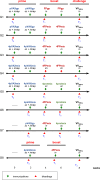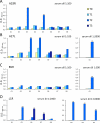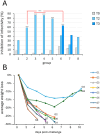Different immunogens and prime-boost vaccination strategies affect the efficacy of recombinant candidate vaccines against pathogenic orthopoxviruses
- PMID: 39511612
- PMCID: PMC11542223
- DOI: 10.1186/s12985-024-02534-4
Different immunogens and prime-boost vaccination strategies affect the efficacy of recombinant candidate vaccines against pathogenic orthopoxviruses
Abstract
Although not as lethal as variola virus (VARV), the cause of smallpox, monkeypox virus (MPXV) represents a threat to public health, with important infection rates and mortality in several African countries and signs of spreading worldwide. MPXV may establish new reservoirs in non-endemic countries and can be considered a possible biological weapon. Human-to-human MPXV transmission is increasing with a growing susceptibility, coincident with the declining herd immunity against smallpox. The emerging threat of MPXV highlights the urgent need for protection from new zoonotic infections, as mankind is completely unprepared for encounters with new viruses. Preventive vaccination remains the most effective control against orthopoxviruses (OPXVs) such as MPXV and prime-boost vaccination strategies can significantly influence vaccine efficacy and enhance immune responses. Our study aimed at characterizing potential vaccine candidates against OPXV infections in a murine model using DNA, viral and protein recombinant vaccines using different prime-boost regimens. The experiments employed Vaccinia virus (VACV) A33, B5, L1, and A27 envelope proteins as immunogens for both priming and boosting. Priming was carried out using a mixture of four plasmids (4pVAXmix), and boosts employed fowlpox (FWPV) recombinants (4FPmix) and/or the purified recombinant proteins (4protmix), all of them expressing the same antigens. One or two doses of the same immunogens were tested and identical protocols were also compared for intranasal (i.n.) or intramuscular (i.m.) viral administration, before challenge with the highly pathogenic VACV VVIHD-J strain. Our results show that a single dose of any combined immunogen elicited a very low antibody response. Protein mixtures administered twice boosted the humoral response of DNA immunizations by electroporation (e. p.), but did not protect from viral challenge. The antibody neutralizing titer was inversely correlated with animals' weight loss, which was initially similar in all of the groups after the challenge, but was then reversed in mice that had been primed twice with the DNA recombinants and boosted twice with the FWPV recombinants.
Keywords: Prime-boost immunization regimens; Enhancement of the immune response; Orthopoxvirus vaccines; Recombinant vaccines against MPXV.
© 2024. The Author(s).
Conflict of interest statement
The authors declare no competing interests.
The authors declare that they have no competing interests, and that the manuscript has been approved by all of the authors for publication in its present form.
Figures



Similar articles
-
Protection of mice against the highly pathogenic VVIHD-J by DNA and fowlpox recombinant vaccines, administered by electroporation and intranasal routes, correlates with serum neutralizing activity.Antiviral Res. 2016 Oct;134:182-191. doi: 10.1016/j.antiviral.2016.09.002. Epub 2016 Sep 13. Antiviral Res. 2016. PMID: 27637905 Free PMC article.
-
Long-Lasting Protection and Dose Optimization of MPXV Polyvalent Mpox mRNA Vaccines Against Lethal Vaccinia Virus Challenge in Mice.J Med Virol. 2025 Jan;97(1):e70143. doi: 10.1002/jmv.70143. J Med Virol. 2025. PMID: 39726255
-
A Nucleic Acid-Based Orthopoxvirus Vaccine Targeting the Vaccinia Virus L1, A27, B5, and A33 Proteins Protects Rabbits against Lethal Rabbitpox Virus Aerosol Challenge.J Virol. 2022 Feb 9;96(3):e0150421. doi: 10.1128/JVI.01504-21. Epub 2021 Dec 1. J Virol. 2022. PMID: 34851148 Free PMC article.
-
Molecular Virology of Orthopoxviruses with Special Reference to Monkeypox Virus.Adv Exp Med Biol. 2024;1451:111-124. doi: 10.1007/978-3-031-57165-7_7. Adv Exp Med Biol. 2024. PMID: 38801574 Review.
-
Poxvirus Vaccines: Past, Present, and Future.Adv Exp Med Biol. 2024;1451:273-287. doi: 10.1007/978-3-031-57165-7_17. Adv Exp Med Biol. 2024. PMID: 38801584 Review.
References
-
- Koblentz GD. The de novo synthesis of Horsepox virus: implications for biosecurity and recommendations for preventing the reemergence of smallpox. Health Secur. 2017;15:620–8. - PubMed
-
- Lewis-Jones S. Zoonotic poxvirus infections in humans. Curr Opin Infect Dis. 2004;17:81–9. - PubMed
-
- Learned LA, Reynolds MG, Wassa DW, Li Y, Olson VA, Karem K, et al. Extended interhuman transmission of monkeypox in a hospital community in the Republic of the Congo, 2003. Am J Trop Med Hyg. 2005;73:428–34. - PubMed

